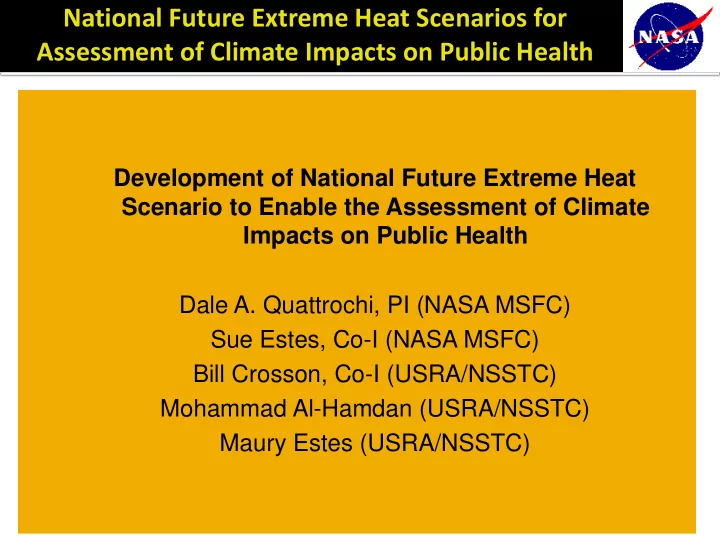

National Future Extreme Heat Scenarios for Assessment of Climate Impacts on Public Health Development of National Future Extreme Heat Scenario to Enable the Assessment of Climate Impacts on Public Health Dale A. Quattrochi, PI (NASA MSFC) Sue Estes, Co-I (NASA MSFC) Bill Crosson, Co-I (USRA/NSSTC) Mohammad Al-Hamdan (USRA/NSSTC) Maury Estes (USRA/NSSTC)
National Future Extreme Heat Scenarios for Assessment of Climate Impacts on Public Health Project Objective: To provide historical and future measures of climate-driven heat events to enable assessments of heat impacts on public health over the coterminous U.S. � The project’s emphasis will be on providing assessments of the magnitude, frequency and geographic distribution of EHEs to facilitate public health studies. � We will focus on the daily to weekly time scales on which EHEs occur, not on decadal-scale climate changes. � There is, however, a very strong connection between air temperature patterns at the two time scales and long-term climatic changes will certainly alter the frequency of EHEs.
National Future Extreme Heat Scenarios for Assessment of Climate Impacts on Public Health 3
Metrics of Excessive Heat 1. Daily Maximum Air Temperature � Daily maximum air temperature, the highest temperature recorded at an observation site between midnight and midnight local standard time, is a traditional measure of heat, and one with which everyone is familiar. We used NLDAS data to calculate daily maximum air temperature. T ( o F) July 15, 2000
Metrics of Excessive Heat 2. Heat Index (HI) We used NLDAS data to calculate daily maximum HI. HI ( o F) July 15, 2000 5
Metrics of Excessive Heat 3. Net Daily Heat Stress (NDHS) Net Daily Heat Stress is a new heat variable that gives an integrated measure of heat stress (and relief) over the course of a day, defined as: NDHS = Σ (HI i – HI hot ) ‐ Σ (T cool ‐ T i ) where the summations are over the hours in a day, but only positive terms are included. In other words, the first sum, the ‘heat stress’, is only calculated when HI i > HI hot , where HI hot is a threshold above which HI is considered a stressor, set to 90 o F. The second term, ‘heat relief’, is only computed when T i < T cool , a temperature below which relief from heat occurs, set to 75 o F. This term is based on air temperature since HI is only defined when T > 80 o F. If heat relief is greater than heat stress, NDHS is set to 0. 6
Metrics of Excessive Heat 3. Net Daily Heat Stress (NDHS) NDHS (degree ‐ hours) July 15, 2000 7
National Future Extreme Heat Scenarios for Assessment of Climate Impacts on Public Health CDC WONDER Climate Change portal.mht
National Future Extreme Heat Scenarios for Assessment of Climate Impacts on Public Health Key Results Expected � GCM-scale monthly climatologies of air temperature and specific humidity for the historical period 1981-2000, and future changes relative to this period. � NLDAS-scale (12km) hourly realizations of temperature and relative humidity. � NLDAS-scale daily T max , T min , Hi max and NDHS. � NLDAS-scale statistics over 20-year past and future periods of heat stress measures. � County-level heat stress measures along with 2040 and 2090 population projections, hosted on CDC WONDER, to enable assessments of heat impacts on public health.
National Future Extreme Heat Scenarios for Assessment of Climate Impacts on Public Health Task Schedule Year 1/Qtr 1 & 2: Obtain GCM monthly mean inputs for 1981-2000 1. (‘current’), 2031-2050 (‘2040’), and 2081-2100 (‘2090’). Year 1/Qtr. 1: Obtain NLDAS data for 1981-2000. 2. Year 1/Qtr 3: Compute monthly differences, averaged over 20-year 3. periods, between future and current climate. Year 2/Qtr. 1: Create hourly climate realizations for 2040 and 2090 4. Year 2/Qtr. 2: Derive HI, NDHS, Tmax, Tmin on daily basis for future 5. climates. Year 2/Qtr. 3: Compute gridded heat stress statistics for future climates. 6. Year 2/Qtr. 3-4: Provide data to CDC WONDER at a county-level scale. 7. Year 2/Qtr 4: End user demonstration. 8. Year 3/Qtr 1: Manuscripts/reports. 9.
Recommend
More recommend